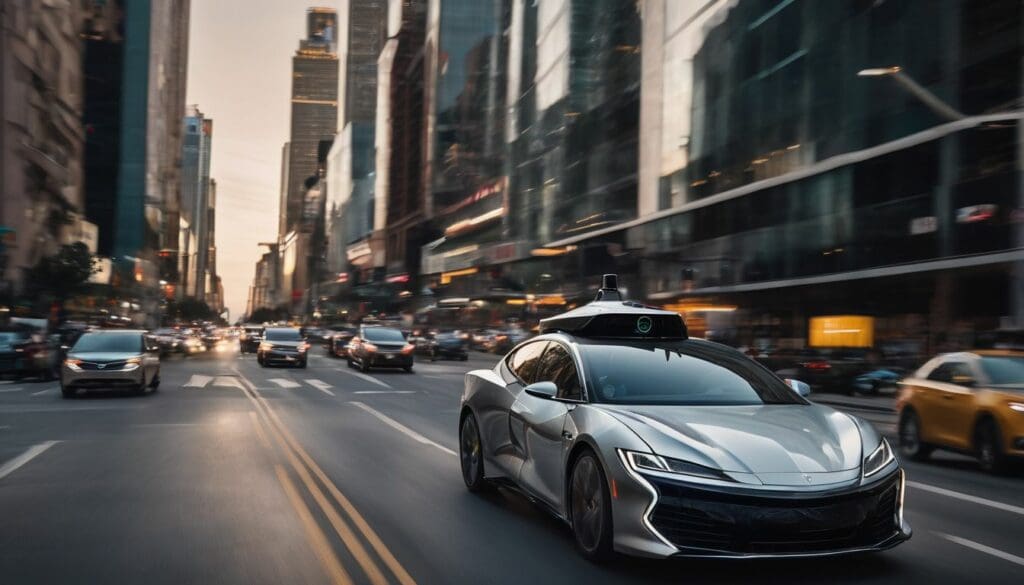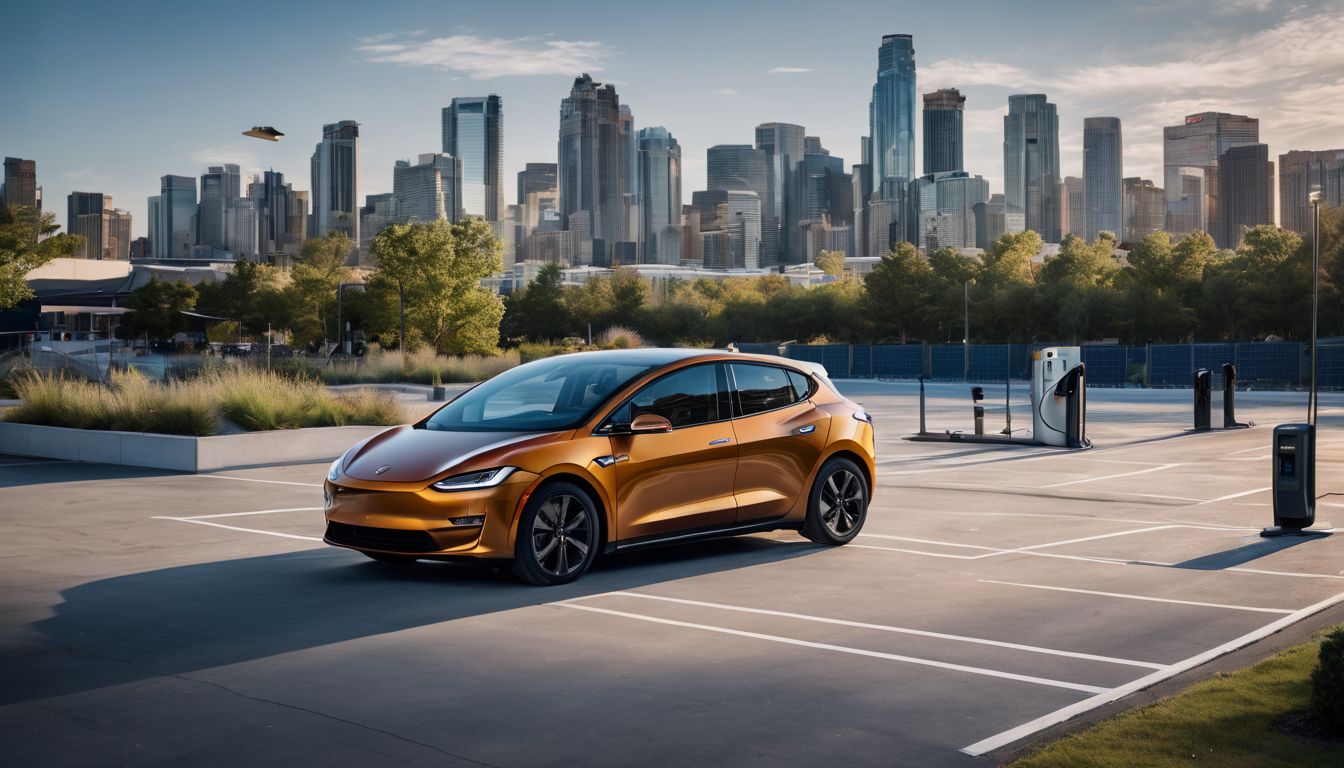We’ve all experienced those moments of apprehension about the safety on our increasingly congested roads. Much like yourself, we’ve channelled that trepidation into proactive measures, revealing a startling statistic: 94% of serious road accidents are attributed to human error.
This article illuminates how the advent of artificial intelligence is revolutionising automotive safety and substantially mitigating those risks. Join us as we delve into AI’s crucial role in safeguarding our future travels.
Key Takeaways
- AI significantly reduces the risk of road accidents by monitoring driving patterns and identifying potential hazards, with systems like collision avoidance and emergency braking enhancing safety.
- Leading companies in the industry, including Waymo, Tesla, and NVIDIA, are incorporating AI into vehicles for safer autonomous driving experiences and to reduce human error on roads.
- The integration of AI in automotive manufacturing processes ensures precision in vehicle construction, resulting in reliable safety features that protect passengers.
- Driver assistance technologies powered by AI not only keep drivers alert to dangers but also support environmental conservation by preventing accidents and reducing emissions from traffic incidents.
- Future advancements in AI promise even more sophisticated safety measures for vehicles that will proactively predict risks and prevent collisions before they happen.
AI in Autonomous Vehicles
AI plays a crucial role in autonomous vehicles, impacting safety through advanced collision avoidance systems and adaptive cruise control. Companies like Tesla, Waymo, and Uber are utilising AI to enhance the safety and performance of their self-driving cars.
Impact on safety
We see artificial intelligence as a game-changer in automotive safety, transforming how vehicles navigate and react to the environment. AI-driven systems like collision avoidance technologies are now capable of analysing data in real time, enabling cars to anticipate hazards and prevent accidents more effectively than ever before.
These intelligent machines adapt to changing conditions on the road, constantly learning and improving with each journey.
In our approach to vehicle automation, we prioritise passenger experience by integrating advanced driver-assistance systems (ADAS) that enhance traffic safety. Machine learning algorithms process vast amounts of sensor data, guiding autonomous vehicles safely through complex urban landscapes.
This increased reliability in decision-making leads not just to fewer collisions but also promotes a smoother flow of traffic—a win for both driver safety and environmental conservation.
Examples of companies using AI for autonomous driving
We’re witnessing a transformative era where artificial intelligence plays a crucial role in the safety mechanisms of autonomous vehicles. A myriad of companies are at the forefront of this innovation, harnessing AI to push the boundaries of what cars can autonomously perceive, decide, and execute on the road. Here’s a snapshot of industry leaders:
| Company | Contribution to Autonomous Driving |
|---|---|
| Waymo (Google) | Developed a self-driving technology known as Waymo Driver, aiming to decrease traffic accidents and carbon emissions. |
| Tesla | Utilises Autopilot and Full Self-Driving (FSD) features to enhance safety while reducing the carbon footprint of daily commutes. |
| Aptiv | Provides advanced safety technologies, software, and systems integration for autonomous driving capabilities. |
| NVIDIA | Employs AI and deep learning through their NVIDIA DRIVE platform to create safer, more efficient vehicles. |
| Mobileye (Intel) | Offers AI-powered EyeQ chipsets to process visual information and mitigate potential on-road hazards. |
| Baidu | Through its Apollo platform, Baidu accelerates the development of autonomous vehicles with an eco-friendly edge. |
| Cruise (GM) | Focuses on all-electric, driverless cars to create cleaner cities with reduced greenhouse gas emissions. |
Each of these companies is contributing significantly to a future where automotive travel is not just safer but also more sustainable. Our roads are on the brink of becoming greener and our automotive experiences smarter, all thanks to the integration of AI in autonomous driving technology.
AI in Manufacturing
AI is not only revolutionising the way vehicles are driven, but also how they are manufactured. The implementation of AI in manufacturing processes has significantly improved safety and efficiency in automotive production.
Implementation in processes
AI is being implemented in the manufacturing processes of automotive safety systems to enhance efficiency and accuracy. Through AI, manufacturing processes can be optimised for better performance and safety. The implementation in processes includes:
- Utilising advanced data analysis to improve vehicle safety features.
- Enhancing fuel efficiency through AI-driven optimisation of automotive engineering processes.
- Implementing connectivity features to enable intelligent transportation systems.
- Using sensor technology and computer vision for improved automotive innovation.
- Integrating intelligent maintenance schedules for enhanced vehicle performance.
Benefits for safety
AI technology in the automotive industry provides significant benefits for safety. Advanced driver assistance systems (ADAS) equipped with AI can detect and respond to potential hazards on the road, significantly reducing the risk of accidents.
By implementing AI in manufacturing processes, automotive companies ensure that vehicles are built with precision and accuracy, contributing to overall safety standards. Furthermore, autonomous vehicles powered by AI have the potential to eliminate human error, making roads safer for everyone.
Looking ahead, the future of AI in automotive safety holds even more promise as technologies continue to evolve and improve. With ongoing advancements, AI is expected to further enhance vehicle safety features and contribute towards a more secure transportation landscape.
AI for Driver Assistance
AI plays a crucial role in preventing accidents through driver assistance systems. These systems use AI to monitor the surroundings, detect potential hazards and alert drivers to take necessary actions.
Role in preventing accidents
AI plays a crucial role in preventing accidents by providing advanced driver assistance systems (ADAS). These systems use AI to monitor the vehicle’s surroundings, detect potential hazards, and assist the driver in real-time.
For example, AI-powered collision avoidance systems can alert drivers of impending collisions and even apply emergency braking if necessary. This proactive approach significantly reduces the risk of accidents, making roads safer for both occupants and pedestrians.
Furthermore, AI helps prevent accidents by analysing driving patterns and identifying signs of driver fatigue or distraction. By recognising these indicators, AI can prompt alerts or interventions to ensure that the driver remains focused on the road.
Use cases of AI in driver assistance
AI plays a significant role in preventing accidents. Transitioning to the use cases of AI in driver assistance, it is vital to highlight how this technology enhances safety on the road.
- Monitoring Driver Behaviour:
- Collision Avoidance Systems:
- Adaptive Cruise Control:
- Lane Keeping Assist:
- Traffic Sign Recognition:
- Emergency Braking Assistance:
Future of AI in Automotive Safety
AI will continue to revolutionise automotive safety, with advancements in technology that will enhance both autonomous vehicles and driver assistance systems. As AI continues to evolve, it will increasingly focus on predicting and preventing accidents before they even occur.
The future of AI in automotive safety holds the promise of even more sophisticated algorithms that can analyse real-time data from connected cars and make split-second decisions to prevent collisions.
In the coming years, we can expect AI to play an even greater role in mitigating risks on the road, providing drivers with enhanced support for accident prevention. This ultimately paves the way for a safer and more secure driving experience while aligning with our commitment to environmental conservation through reducing road accidents.
The potential impact of AI in automotive safety is set to redefine the landscape of transportation for generations to come.
6. Conclusion.
Conclusion
In conclusion, artificial intelligence (AI) is revolutionising automotive safety by enhancing autonomous vehicles, optimising manufacturing processes, and providing advanced driver assistance.
Companies are harnessing AI to prevent accidents and improve road safety. As technology advances, the future of AI in automotive safety holds promise for even greater advancements in protecting drivers, passengers, and pedestrians.
The role of AI in automotive safety is pivotal for the continuous improvement of vehicle safety standards.
FAQs
1. What does artificial intelligence do for automotive safety?
Artificial intelligence in automotive safety analyses data to help cars understand their environment, making driving safer with advanced driver-assistance systems (ADAS).
2. Are vehicles with AI more reliable on the road?
Yes, vehicles equipped with AI and ADAS technology can better detect potential hazards on the road, reducing the risk of accidents.
3. How does AI improve a driver’s reaction time?
AI in automotive technology can alert drivers quicker to unexpected events, allowing for faster response times that could prevent collisions.
4. Can artificial intelligence take control of a car if needed?
In certain situations, AI-supported systems can take action, like automatic braking or steering correction, to avoid danger and enhance vehicle safety.





